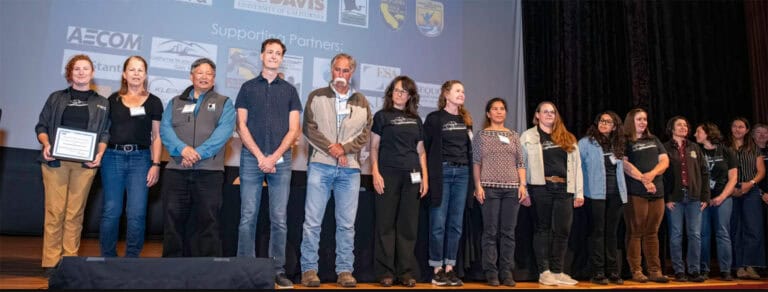Photo: May 2024 – State of the Estuary conference awards ceremony for outstanding projects.
It wasn’t the appearance of a flashy, high-ranking California official at the podium, or the review of 35 years of efforts to protect the Bay’s watershed at the beginning of the May 2024 State of the Estuary conference that made me sit up in my red velvet auditorium seat. It was an awards ceremony for outstanding projects. Usually a rather dull procedural item in my experience of half a dozen such conferences, this one’s message was nothing anyone said or put up on the screen.
“We’re comfortable with failure in grey infrastructure but not green infrastructure, so we have to build projects now that leave the door open for learning.”
Julie Beagle
U.S. Army Corps of Engineers
There to receive each small plaque from Friends of the Estuary were long lines of “collaborators.” As they snaked on and off the stage for a photo and handshake, the line of folk who had helped complete this or that project — from mapping the range of the salt marsh harvest mouse to involving students and teachers in watershed restoration — got longer and longer. In these humble lines of changemakers, no one was taking selfies or fist-pumping or even expecting to hear their own name spoken into the mike. These are just the folks quietly going about saving the planet — year after year. It was heartening to see such unity compared to the daily news headlines.
“While we are in a geopolitical moment of many crises, with few glimpses of hope, [the Bay Area], as a place with a comprehensive, intersectional view of society, continues to create solutions,” California’s Secretary of Environmental Protection, Yani Garcia, had just said in her prior speech. And there it was right in front of us.
“A dollar spent in community has a bigger impact then any dollar spent in a corporation or in government.”
Yani Garcia
California Secretary of Environmental Protection
Though the region’s ability to collaborate with other agencies and scientists and managers to protect and restore the San Francisco Estuary has grown exponentially, over the years, these same folks are now tangling with a new challenge: how to make this work relevant to the Bay Area’s most “underserved” communities. Instead of planning projects on their doorsteps and then asking residents for their feedback, efforts are being made to incorporate community vision from the get go, and even to pay for it. And to listen to what these communities can teach the “experts” about resilience. It’s a new paradigm for urban planning.
“A dollar spent in community has a bigger impact then any dollar spent in a corporation or in government,” said Garcia.
One other session attended by this reporter stood out in a conference that leaned much more heavily into the people side of a healthy estuary than the usual science. In this session, the SF Estuary Partnership’s Diana Fu asked three members of the next generation to comment on their experiences of the Estuary and the challenges […]
Full article: www.kneedeeptimes.org

